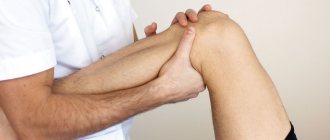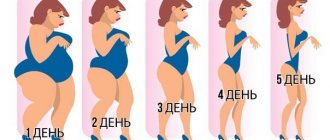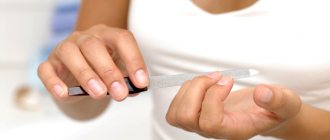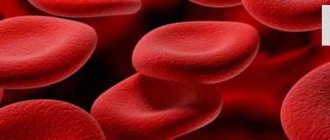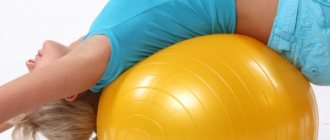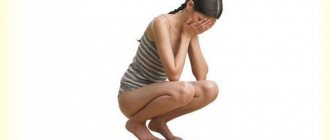What is sore throat and what are its symptoms?
Why do we feel muscle pain after exercise?How to alleviate your condition?In what cases should you consult a doctor?What helps prevent the appearance of sore throat?
So, you've decided to exercise and become a little healthier and slimmer. Your first workout was productive and fun, leaving home you are proud of yourself. Go to bed with this feeling, and in the morning you can hardly lift your toothbrush to brush your teeth. Sound familiar? Many questions arise: “What happened? Did I do something wrong? Was there too much workload? Don't let the sore throat confuse and scare you! Everyone who engages in any physical activity has experienced muscle pain at least once. We'll tell you everything you need to know about it.
What is sore throat and what are its symptoms?
Krepatura is muscle pain associated with physical activity. Develops after excessive or unusual exercise, including eccentric exercise. These include push-ups, pull-ups, weighted squats, dumbbell up presses and other complexes that involve muscle contraction while lengthening.
Types of muscle contractions
Krepatura is caused by microscopic damage to muscle fibers, which leads to painful sensations.
Symptoms include the following:
- severe muscle pain and fatigue
- decreased range of motion and stiffness
- swelling of the affected muscles
- short-term loss of muscle strength
Regardless of fitness level, soreness can be felt by anyone who begins a new exercise program, increases its duration or intensity, or uses weights that the body is not accustomed to.
The soreness usually lasts from 3 to 5 days. And pain occurs 1 or 2 days after training.
Causes of sore throat
Before giving advice on how and how to relieve muscle pain after physical activity, detailed information about this phenomenon should be given. Previously, scientists believed that lactic acid was to blame for pain - it reaches high concentrations in muscles during the breakdown of carbohydrates and the synthesis of adenosine triphosphate. Simply put, during intense physical activity. But later it was found that the level of lactate, along with other by-products of glycolysis, drops within a few hours - that is, even before the first unpleasant sensations appear.
SOMB occurs due to excessive swelling of muscle fibers and inflammation. The fact is that with unusual activity, micro-tears appear on the tissues - they are not dangerous in themselves. Nutrients and substances that promote regeneration, including prostaglandins and leukocytes, arrive to “repair” them. Their strong influx provokes swelling, which, together with inflammation, is the cause of pain.
Comment from Elena Morozova, a nutritionist at the weight loss clinic:
It should be understood that such a reaction of the body is quite natural if you had to experience an unusually large load. How can you avoid muscle pain after exercise without having to deal with intense burning and discomfort? Gradually increase the duration of classes and introduce new exercises with caution. The clinic’s specialists will help you create an individual program, following which you will not have to experience discomfort. A reasonable pace and correct technique mean high efficiency and pleasant fatigue.
Why do we feel pain after exercise?
There is a myth that sore throat occurs due to the accumulation of lactic acid. Allegedly, it clogs the muscles and affects blood flow. In fact, the acid remains in the body for up to half an hour, and then is safely eliminated, which indicates that such a hypothesis is unfounded.
The fact is that weight training and eccentric exercises cause micro-tears in muscle fibers, which provoke increased blood flow and minor inflammation (you may even notice a little swelling). This stimulates pain receptors in muscle cells and makes them more sensitive to movement. It sounds scary, but in reality there is nothing dangerous about it. The muscle damage is temporary. They recover and become stronger, withstanding heavier loads. This is an integral part of the adaptation process, which applies to both amateurs and experienced athletes. Soreness decreases as the muscles get used to the new physical activity.
How to determine a gap?
As already mentioned, most often the biceps muscle hurts due to ruptures that occur due to excessive physical exertion. Determining the occurrence of a rupture is quite simple, because this pathology is manifested by characteristic symptoms, represented by:
- Sometimes an audible click or crunch that can be noticed at the moment of rupture.
- The unexpected appearance of acute painful sensations in the shoulder. Subsequently, there is a gradual decrease in pain and its complete disappearance after 3 weeks from the moment of injury.
- Pain and discomfort that is felt when trying to tense the muscles.
- The appearance of bruises on the shoulder from the front side. After 2-3 days, you can observe a gradual movement of the bruise, which expands and can reach the hand.
- When palpating the muscle, characteristic soreness is also noted.
- Weakness in the movements of the shoulder and elbow joints.
- Difficulty turning the forearm.
Unfortunately, it is quite difficult to independently determine an injury, because this requires a qualified approach. Therefore, it is highly recommended to consult a doctor if your biceps hurt. This should be done immediately to make you feel better and ensure proper recovery.
We recommend reading: How much weight can you lose in a month with proper nutrition and exercise?
Is soreness a sign of a good workout?
Some people think that if you don't feel very sore and exhausted after a workout, you shouldn't expect good results. As they say, “no pain, no gain.” Is it so?
No . When you start a new workout or add additional loads, soreness is inevitable. But the longer you practice the same pattern and the more muscles you use, the better your body adapts.
Exercises become less painful, but this in no way means that you are not training hard enough. When muscles get used to a certain stress, they quickly adapt and stop overreacting.
If you frequently suffer from muscle pain and stiffness, you may need to add more rest days or reconsider the intensity or duration of your workouts, otherwise you may be at risk of overtraining
.
Treatment of inflammation and sprains at home
Here are step-by-step instructions for quick rehabilitation of inflamed ligaments (or mild sprains) when your arms cannot be straightened:
- The first step is to apply cold to the problem area.
This can be any item from the refrigerator if there is no ice on hand.
The purpose of a cold compress is to relieve swelling and prevent inflammation. The duration of the procedure is 15-30 minutes.
- The next step is taking non-steroidal anti-inflammatory drugs and ointments
The working ligament is a Nimesil sachet and Diclofenac ointment. These drugs have analgesic, anti-inflammatory and analgesic effects.
“Nimesil” is taken 2-3 sachets per day. Usually 2-3 days of use are enough to significantly reduce pain.
Diclofenac ointment is rubbed into problem areas 2-3 times a day for 5-7 days. Even if you no longer feel pain in the ligaments, this does not mean that everything is fine.
Residual inflammatory processes last for several more days. Therefore, to avoid recurrence of the injury, it is advisable to use the ointment for another 2-4 days after the end of the pain syndrome.
If you simply have severe soreness the day after training, and your arms do not bend or straighten, physiotherapy and ointments with a warming effect will come to the rescue.
The most effective and quick way to relieve soreness is a bath or sauna, a warm bath, massage or self-massage, and light stretching. The essence of all these procedures is to increase blood flow to the hypertensive area.
For the same purpose, various warming ointments are used. Apizartron ointment, which contains bee venom, has proven to be very effective in sports.
The hardest thing (especially for beginners) is to correctly determine the cause of pain in the hands. And if everything is more or less clear with a serious injury, then sore throat and inflammation of the ligaments are often confused.
The fact is that if the ligaments are sprained and inflamed, the injured area should not be exposed to heat for the first 1-2 days. Only cold and anti-inflammatory drugs. You can warm them up from 3-4 days.
But with sore throat, warming procedures begin from the first day of pain.
If you doubt the nature of the origin of the pain, then take anti-inflammatory drugs and ointments for the first day or two.
If the unpleasant sensations have sharply decreased in a couple of days, it means that it was a sore throat (the ligaments hurt a little longer and the pain goes away smoothly, gradually), and you can use warming ointments.
What is overtraining and how does it manifest itself?
Just a month ago, you did everything to not miss a workout. In the literal sense of the word, they ran to the gym, favorite studio, arena, stadium or park. At some point, it might seem to you that the result has stopped improving, the tasks have become too easy to complete, and following these thoughts, motivation has disappeared. At such moments, inadequate goals are born in the head and a desire appears to jump above one's head - suddenly run a marathon, lift too much weight, or perform 4 sets instead of the usual two. As a rule, overtraining is observed during this period. It is also accompanied by emotional swings, fatigue, irritability, tachycardia, etc. Overtraining can be functional, sympathetic or parasympathetic.
Take a simple test that Finnish physiotherapist Heikki Rusko developed for skiers. Put on the heart rate monitor and lie down in a comfortable position. After 10 minutes, record your pulse while lying down. Then stand up and check your pulse again after 15 seconds, then after 60 and 120 seconds. You will get four indicators. If the difference between the first and fourth measurements is 10 beats or more, you have not recovered enough or are overtrained.
It can be treated simply - rest and moderate exercise. But it is better not to allow such a state to occur in the first place.
Is it possible to exercise during a fever?
Typically, training programs are designed to allow 1 to 2 days between workouts for muscle recovery.
Don't do exercises on muscle groups that hurt. Do a leg workout on one day and an upper body workout on the next to avoid full-body soreness.
Do you need to exercise when you have sore throat?
Let's play ball
The choice of massage device depends on which muscles need relaxation. The surface of such devices - balls, cylinders and rollers - is non-uniform, which gives the effect of a finger massage. This allows you to influence the points of greatest muscle tension, the so-called trigger points. This term was introduced into the scientific lexicon by Janet Travell .
“Our fitness club is equipped with Trigger Point equipment. Even if the trigger points are “hidden” deep, for example on the neck, you can still reach them with a massage ball. This way you can work out different parts of the body: neck, lower leg, quadriceps femoris muscle. These areas of the body cannot be called difficult to reach, but it is not so easy to massage them effectively on your own,” the expert believes.
According to the fitness manager, there are a total of six trigger point locations on the body. If desired, the self-massage device can also be used to relax the core muscles.
“These (core muscles - editor's note) are the muscles that ensure a stable position of the spine, pelvis and hips. For example, if these muscles are weak, then you can get a lower back injury when doing push-ups (when the main load seems to be on the shoulders). Trained core muscles are our frame, this is the muscle tone that supports the body day after day,” explained Rzhevtseva.
These include, for example, the obliques, gluteus minimus and medius, the transverse abdominis and other muscles.
As an advertisement
How to relieve muscle pain after exercise?
When your whole body aches and your limbs have difficulty lifting and turning, it is tempting to rest and avoid any exercise. The reaction is understandable, but wrong, since immobility will only increase pain and stiffness, rather than ease it. This does not mean that you need to overstep yourself and do intense exercise. Small exercises throughout the day are enough. Yoga, moderate walking, cycling or swimming are great options to relieve pain.
In general, the best cure for sore throat is time.
Helper Methods
There is no clear way to treat sore throat, but it is possible to ease the pain. This is actively used by both professional athletes and amateurs.
Massage
Several overseas studies have shown that people who received massage 24 or 48 hours after an intense workout reported significantly less muscle soreness compared to those who did not. Massage was found to be most effective 48 hours after exercise.
Self-massage of painful areas helps: arms, legs, buttocks, shoulders, as well as the use of a foam roller (they are also called rollers). The roller helps relieve tension, improves blood circulation and prevents muscle spasms.
Self-massage of muscles using a roller
Analgesics
Analgesics are medications intended for pain relief. The first to come to mind are Analgin and Aspirin, but there are also more suitable non-steroidal options - Ibuprofen.
You can also use external ointments and gels that contain menthol, capsaicin, methyl salicylate and are applied topically to the skin.
It is important to strictly follow the instructions on the packaging and understand that such products will not give anything other than pain relief. They will not make muscles work better, will not speed up recovery, and will not prevent the appearance of sore throat in the future.
Cold bath
A 2021 study claims that immersing the whole body in a cold water bath (10-15°C) for 10-15 minutes reduces muscle pain.
This is one of the most popular self-medication methods among athletes. Also, some of them apply ice bags to the painful points.
If ice water is too extreme for you, try warm water or wet wraps.
Anti-inflammatory foods
Diet matters too. The more you consume foods rich in vitamins A, C and E, the better your body will tolerate stress. Foods useful for recovery: eggs, cinnamon, starchy vegetables, fish, fruits with a high glycemic index, as well as dark fruits (cherries, blueberries, cherries, etc.).
What to do
So we have established the causes of pain in the arms after exercise. This is a severe soreness of the biceps, inflammation (strain) of the biceps ligament or injury to the elbow ligaments.
If you have severe acute pain in the elbow joint, which worsens with the slightest flexion and extension of the arm, and there is swelling and redness (in severe cases, hematoma) of the injured area, most likely this is a ligament injury.
In this case, it is necessary to urgently consult a traumatologist for diagnosis and prescribing a course of treatment.
If the pain allows you to move your arms, albeit with difficulty and discomfort, then we are most likely talking about severe sore throat or inflammation of the ligaments. This problem can be dealt with even at home.
Usually, severe soreness in the biceps goes away on its own within 3-5 days. If inflammation of the ligaments occurs, complete rehabilitation takes from 7 to 14 days.
This process can be accelerated if you perform a number of recovery procedures, which we will discuss further.
In what cases should you consult a doctor?
You should seek medical help immediately if:
- your sore throat does not go away for more than 7 days
- urine has become too dark
- severe swelling appeared in the arms and legs
Krepatura can be a mild form of metabolic poisoning called rhabdomyolysis, or rhabdo for short. It occurs when large amounts of a protein called myoglobin enters the bloodstream. Myoglobin is responsible for storing oxygen in the body and affects the kidneys, including causing kidney damage or even failure.
Pain that lasts longer than a week, or is so severe that it interferes with full movement, indicates serious muscle problems that can lead to kidney damage. If the discomfort does not decrease and the urine has become dark (the color of black tea), this is an alarming sign indicating that an urgent medical examination is necessary.
Sometimes along with sore throat comes a slight increase in body temperature. As a rule, within 37+. There is nothing wrong with this if it lasts no more than a day.
Medical care for muscle pain
What helps prevent sore throat?
It is impossible to completely avoid sore throat, but there is a chance to reduce the intensity of muscle pain. What does that require?
- Stay hydrated. There are studies that show that muscle pain is significantly reduced by drinking water before, during and after exercise.
- Warm up. To warm up your muscles, spend 5 to 10 minutes before each workout doing some dynamic stretching exercises. This helps prepare the body for intense exercise and protects against possible injuries. Leave static stretching for the post-workout period, it helps increase flexibility in joints and muscles.
- Increase the load gradually. Take pity on your body and don't stress it with sudden changes in the amount and intensity of exercise. Increase sets, reps, and weight by no more than 10% per week. Build up your strength and endurance systematically.
Be patient! If you are taking the first steps on your sports path, start them with classes with a trainer. He will bring you up to date, write out an individual training plan and minimize the risks of injuries, including muscle pain. Half-hour classes at FitCurves provide optimal exercise and help you stay toned.


